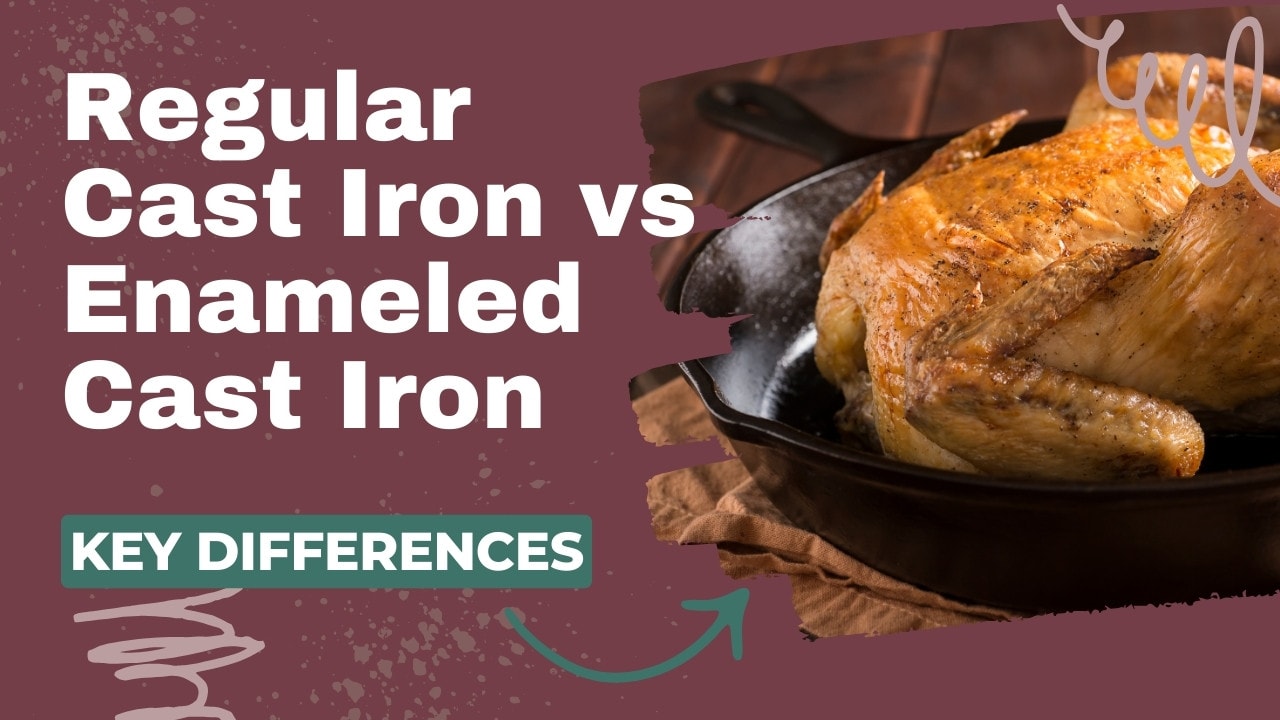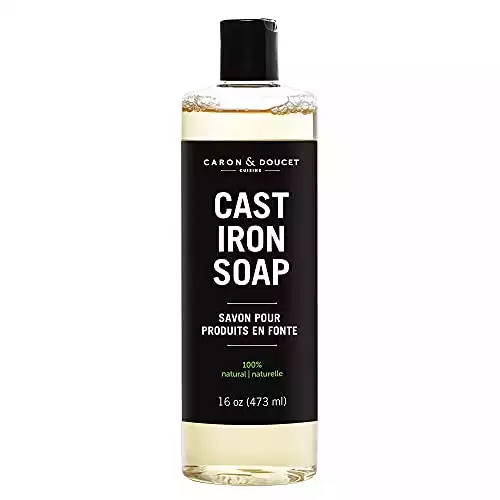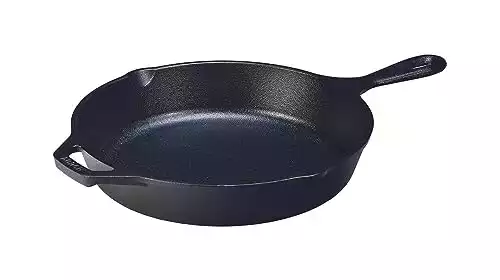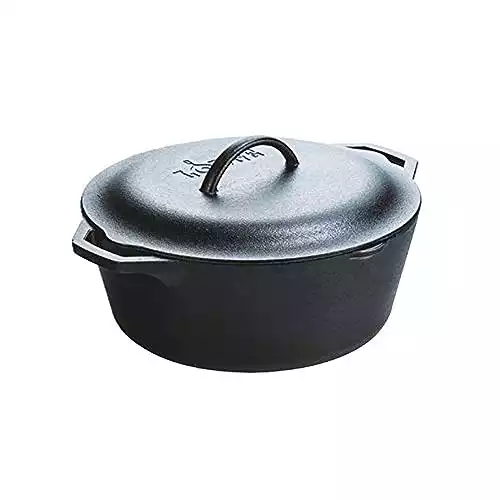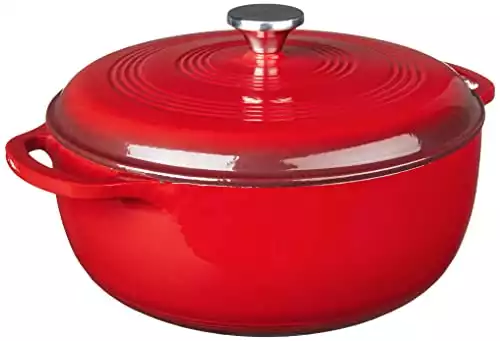If you’re in the market for cast iron cookware, you might be shocked at the price difference between traditional cast iron and the gorgeous, colorful enameled type. At their core, they’re both a single chunk of shaped iron, but one is coated in decorative glass-like enamel, and one is left raw. The coating affects way more than price and appearance; it affects how it cooks, cleans, and keeps, too.
Regular Cast Iron vs Enamel Cast Iron Cookware- Key Differences
Regular and enameled cast iron both start with the same manufacturing process: Melted iron is mixed with carbon and poured into a mold, producing the basic body of the cookware.
But regular cast iron consists of bare metal with no finishes, while enameled cast iron goes through a coating process.
The enamel is made of glass powder melted and fused onto the underlying metal, then fired and cured. The resulting coating is hard, durable, and scratch-resistant. It’s also non-reactive and perfect for simmering acidic foods.
But if you’re cooking on the stove, you’ll find that enameled cast iron isn’t as nonstick as a well-seasoned cast iron skillet. It also may crack with high heat. So, you may want to use regular cast iron for searing and frying.
Pros and Cons
Regular Cast Iron
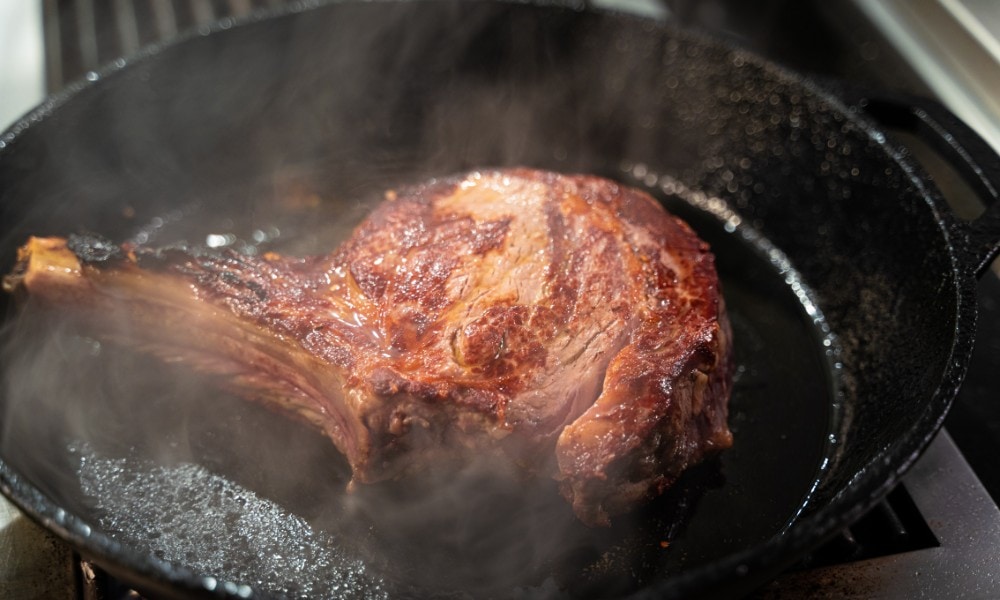
Pros
Cons
Enameled Cast Iron
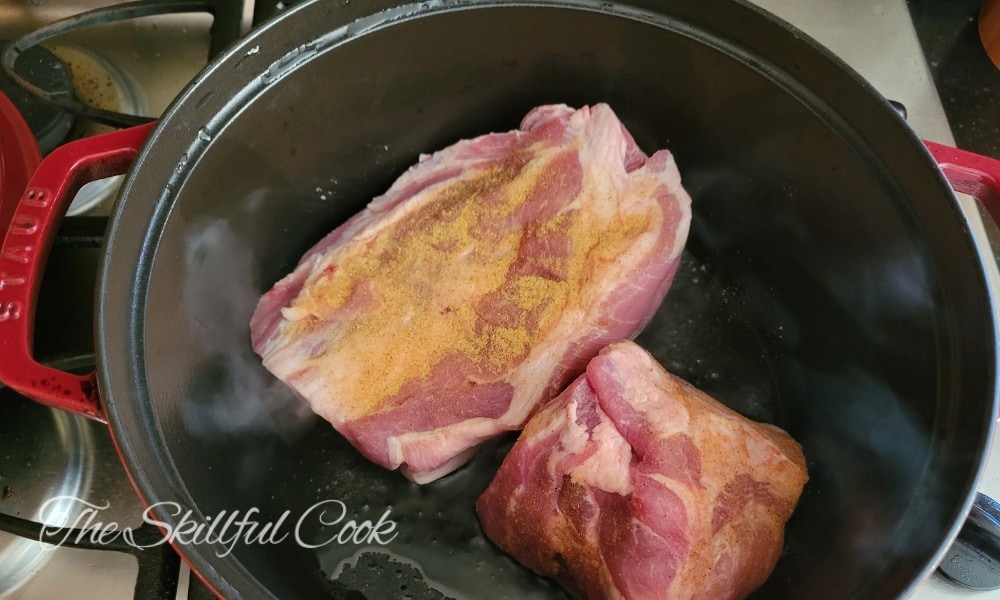
Pros
Cons
Both regular cast iron cookware and the enameled version are heavy, have excellent heat retention, can last for many years, and are commonly regarded as health-conscious cookware choices. Both are good for baking.
Related: Enameled Cast Iron Pros and Cons
Care/Maintenance and Ease of Use
Cast iron is strong and durable. But it’s not maintenance-free.
Raw cast iron is not nonstick and can rust if exposed to humidity. So, it needs regular seasoning to create a protective patina that makes it nonstick and rust-resistant. You should dry it after you wash it and keep it in a dry place to prevent rusting.
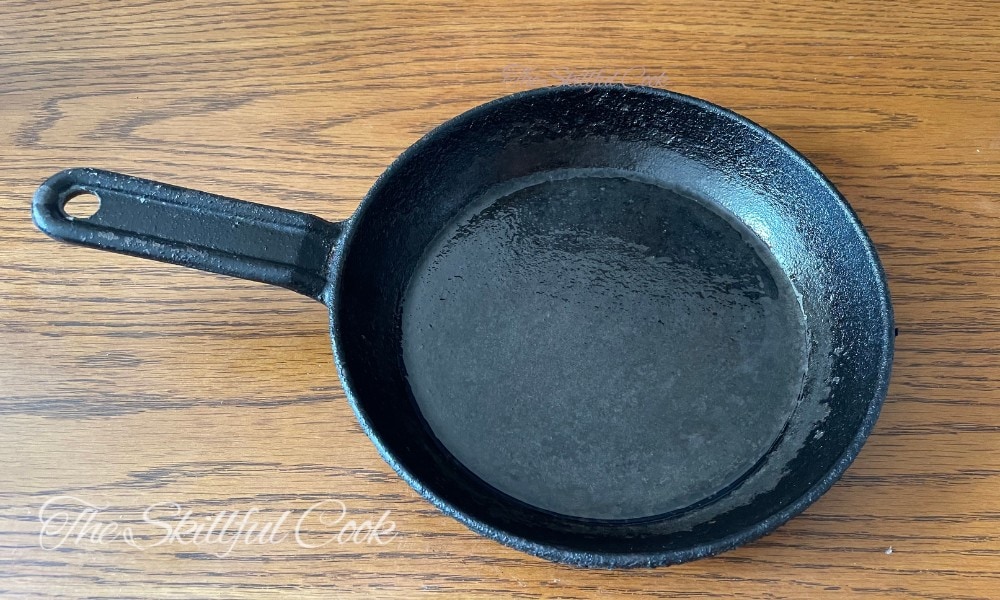
Enamel cast iron doesn’t need seasoning, so it’s easier to maintain. It already has a hard, enamel coating that makes it semi-nonstick and easier to wash.
I’d say, though, that a well-seasoned standard cast iron pan is also easy to clean. If your cast iron has a great, smooth, and even patina on it, even eggs should slide off it without sticking. In this case, you’ll just need to wipe it with a dot of iron-safe soap, or a salt-and-oil mixture. But if the seasoning gets patchy, food can bond with cast iron, leaving you with a tough job ahead.
✅ Coconut Scent
✅ Free of sulfates, phosphates, parabens & petrochemicals
✅ Removes odors
✅ 100% Natural and Plant Based
Longevity and Nonstick Abilities
Good cast iron cookware can truly become an heirloom. It’s among the few cookware options with exceptional longevity if you take care of it properly.
Even rusty iron cookware can be salvaged. In fact, perhaps the only way a cast iron pan can be damaged beyond repair is if it cracks from thermal shock.
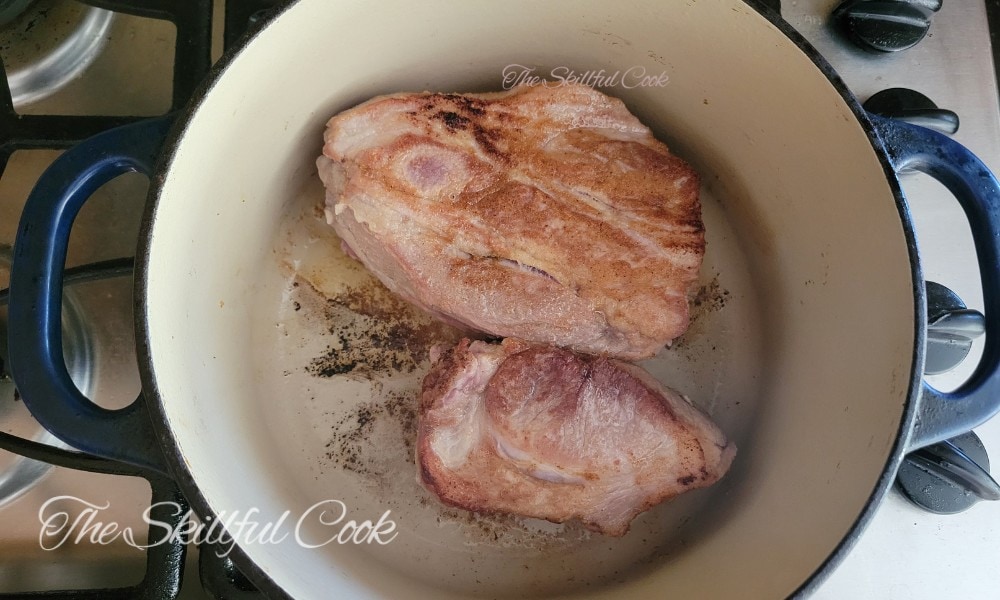
Enameled cast iron is also super durable, since it has the same core material. There are definitely tales of Le Creuset pots lasting for generations! But the enamel coating can be damaged more easily. Rough handling or metal utensils can damage or scratch the coating.
Nonstick Cooking Experience
Since natural cast iron builds up layers of smooth seasoning, it can get better with time. The more you cook with your cast iron skillet, the more layers of coating build. As long as you make sure to scrub away any carbonized food, the increased layers will make your cast iron pan more nonstick with time.
On the other hand, enameled cast iron may get less nonstick as time goes on. It’s not 100% nonstick to begin with – you will still need to use oil when cooking on it – but it may stick even more over time as the enamel thins. You may be able to season damaged enamel cast iron cookware, but the results might not be effective – or pretty.
Acid Resistance
When it comes to acid resistance, enamel cast iron takes the crown. The glaze is hard enough to prevent acidic foods from wearing it down.
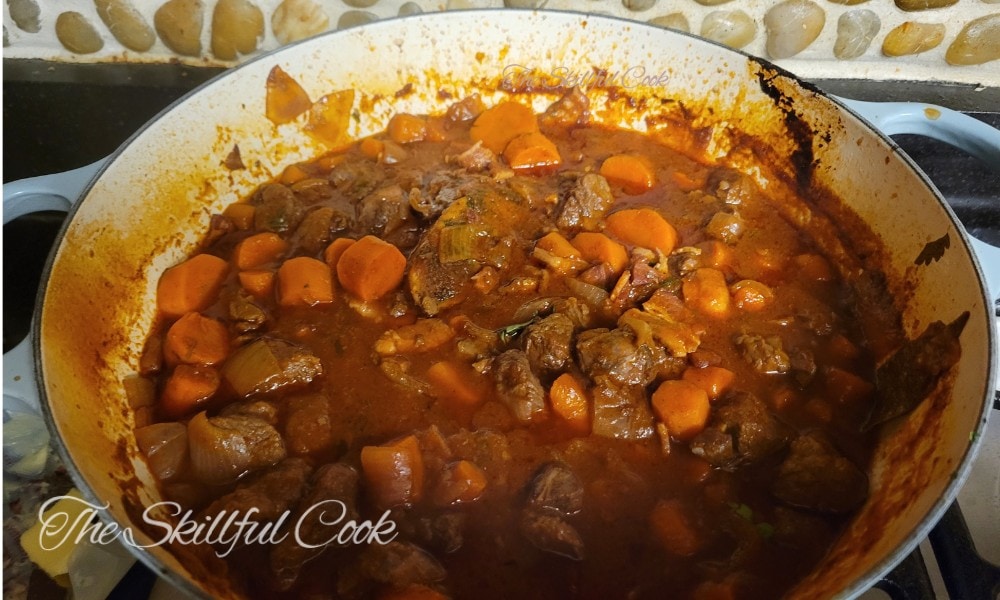
Regular cast iron reacts with acidic foods. Cooking acidic foods in a cast iron skillet may give your food metallic flavors. If your skillet is perfectly seasoned, it takes longer for acids to break down the seasoning and reach the iron itself. But if you simmer acidic foods in your skillet or Dutch oven for long periods, it can strip the seasoning – dissolving it into your food – and begin to eat away the metal.
Versatility
Cast iron lends itself to almost all kinds of cooking. You can use it for searing, boiling, frying, and simmering. But regular and enameled cast iron are ideal for different types of cooking.
As I mentioned, natural cast iron is reactive, so you shouldn’t use it for simmering or braising. You also shouldn’t use it for storing, marinating, or refrigerating food. However, thanks to its protective coating, you CAN use enamel cast iron for all these applications.
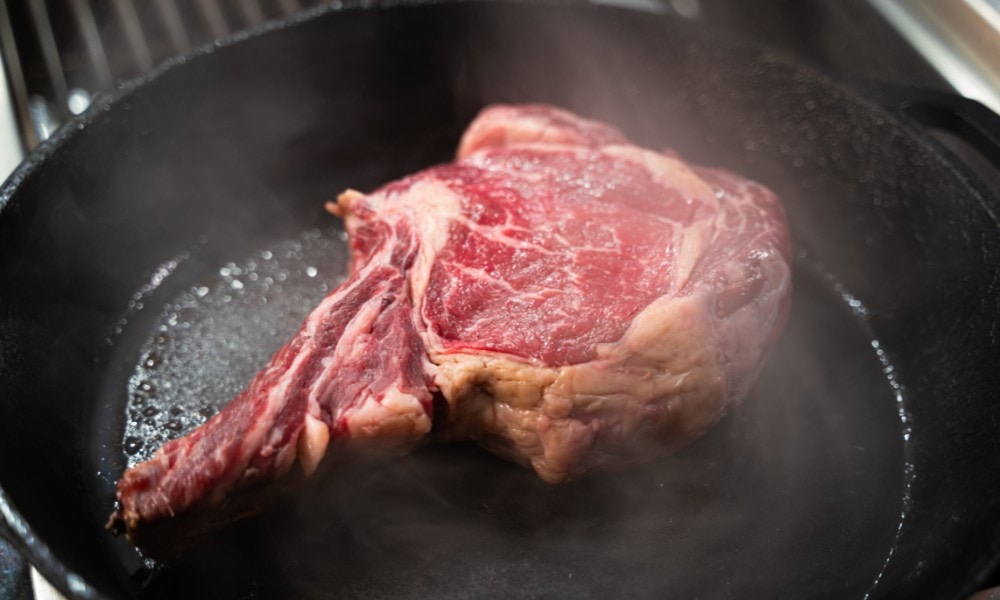
But since enameled cast iron isn’t fully nonstick and doesn’t do well with high temperatures, you may want to go with your natural cast iron skillet for searing steak or veggies.
If you’re in the market for cast iron but don’t have either type yet, I’d recommend getting a raw cast iron skillet (for only about $20!) and an enameled Dutch oven.
✅ Preasoned
✅ Naturally stick-less
✅ Unparalleled heat retention
✅ PFOA & PTFE free
Heat Transfer and Retention
Cast iron cookware – whether enameled or not – is made of 98% iron with 2% carbon. Since the added carbon makes cast iron brittle, it needs to be made thick.
Due to its thick, heavy construction, both raw and enameled cast iron cookware hold on to heat for a very long time. This makes these pans fabulous for searing, braising, or slow cooking. But they are not very “responsive” cookware choices. In layman’s terms, this means they don’t heat up quickly or transfer that heat evenly to other parts of the pan or the food inside. While heating, they may develop hot spots.
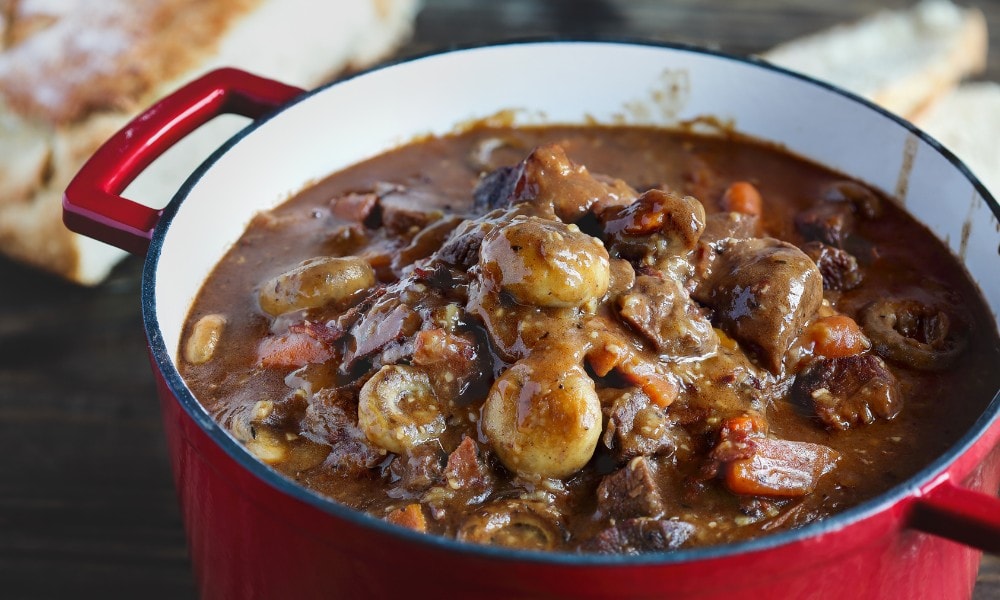
The hot spot problem is less serious with enameled cast iron since the enameled surface helps the heat spread more evenly. But with both types, you should heat up the cookware slowly to allow for more even heat distribution.
Price
Enameled cast iron is universally more expensive than bare cast iron. Compare this raw cast iron Dutch oven from Lodge with an enameled one of about the same size that costs $30 more.
Uncoated cast iron doesn’t vary too much in price from brand to brand. But there’s a massive range in prices between brands and styles of enameled cookware.
✅ Oil rubbed finished
✅ Loop handles
✅ Unparalleled heat retention and even heating
✅ Pre-seasoned
French-made brands Le Creuset, Made In, and Staub are household names, and their rigid quality control processes are reflected in their price tags. You can buy much more affordable enameled pots if you’re willing to flex on quality.
Colors/Appearance
If there’s one area where enameled cast iron is the definite winner, it’s appearance. All raw cast iron cookware is black and looks the same.
You can find much more variety in the enameled cookware department. The shiny and glossy glazing gives it a visually attractive look. It comes in a wide range of colors that can match your decor. The interior glazing may be black or white, depending on the brand.
✅ Oven safe up to 500°F
✅ Easy to cook and clean
✅ Superior heat distribution and retention
✅ Non-toxic, PFOA & PTFE free material
Health/Safety Concerns
Both enameled cast iron and natural cast iron are considered generally safe cookware materials. The coating on enameled cookware is made of powdered glass, so it doesn’t contain Teflon or “forever chemicals” (PFAS). It also creates a barrier between your food and the underlying iron, preventing iron from leaching into your food.
There are concerns about the presence of lead, especially in artisan enameled cast iron cookware. Historically, lead was used to create the glassy finish in ceramics, and heavy metals such as cadmium were used as pigments.
When shopping for enameled cookware, buy only from reputable manufacturers that comply with Proposition 65 and FDA regulations regarding heavy metals in cookware.
(We share additional research on this topic in our article Is Enameled Cast Iron Safe?)
Raw cast iron is also usually considered healthy cookware. However, it can react with acidic foods and does leach iron into your food. This may not be a concerning health issue unless you have a blood iron overload. In fact, in some cases, medical professionals suggest there may be benefits from iron added to people’s diets through cookware.
Closing Thoughts
Regular and enameled cast iron are both great options if you want to enjoy the pleasures of cooking with cast iron.
Enameled cast iron is better for simmering and storing acidic foods thanks to its acid resistance. But bare cast iron is perfect for searing and frying, especially when seasoned well.
Do you have raw and enameled cast iron cookware? Which one do you prefer? Please share your thoughts below.

